Modern organizations regularly process tons of text data: surveys, comments, patient information, credit histories, etc. Handling a lot of diverse text-based data quickly and thoroughly to provide quality services and maintain work processes is almost impossible. Organizations also have to deal with issues like data overload, manual processing inefficiencies, and the potential for human errors.
One way to overcome such challenges is by analyzing data using text mining solutions, which are often powered by artificial intelligence (AI) algorithms. Such software can help organizations significantly accelerate data handling: for example, by immediately summarizing thousands of documents. Businesses can also use text mining solutions to improve the quality of their work, such as by responding faster to customer feedback.
In this article, you’ll find a comprehensive overview of AI-powered text analysis, its applications, techniques, and potential business benefits. We also discuss the main stages of this process and key considerations for developing text mining functionality.
This article will be helpful for product and development leaders who are considering building text analysis software or enhancing an existing product with such functionality.
Contents:
AI text analysis: definition and applications
Imagine a business that needs to analyze a few thousand customer surveys to prioritize problems to solve. Or a product team that has to find relevant data for AI chatbot development or software knowledge base. Performing such tasks manually is time-consuming, but companies can benefit from an automation solution based on text mining.
What is text analysis?
Text analysis (also called text mining) is the process of using computer systems to read and understand unstructured and semi-structured text data. Since modern text mining software often leverages artificial intelligence and machine learning (ML) technologies to provide advanced features and more accurate results, this process is often called AI text analysis.
Functions of text analysis solutions include classifying, sorting, and extracting information from a given text or texts. The common goal of this process is to identify patterns, relationships, sentiments, and more. Thus, various organizations are able to improve and accelerate business operations. For example, classifying and sorting data can streamline workflows, improve decision-making, and enhance customer service.
You can use text mining to automatically process data from multiple sources like documents, reports, emails, social media posts and comments, and product reviews. By leveraging text mining solutions, businesses are able to quickly get valuable insights, trends, and patterns out of tons of text data.
How can you use text mining?
AI text analysis solutions can have different applications depending on what features they provide. Below, we list the four most popular text mining applications and provide a few examples of their use cases for different industries.
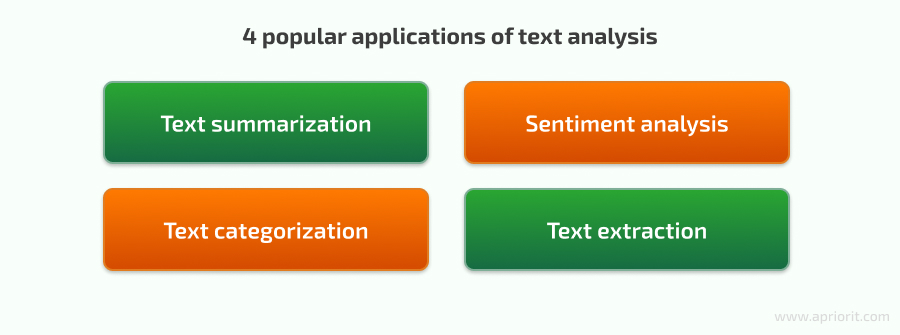
- Text summarization is the process of condensing a text into a shorter version while preserving crucial information and meaning. Text analysis solutions locate the most important phrases and sentences in a given document and provide users with a summary that accurately represents the contents of the original document. Organizations benefit from this use case when summarizing research papers, medical reports, HR surveys, customer reviews, etc.
- Sentiment analysis is the use of AI algorithms for deciphering human emotions and opinions. Also known as opinion mining or emotion AI, sentiment analysis determines if the tone of a given text is positive, negative, or neutral. AI sentiment analysis in text processing is especially helpful for businesses that need to analyze thousands of customer reviews and social media comments.
- Text categorization, also called text classification, is the process of assigning categories to a given piece of text data. A text classifying solution associates certain keywords within texts with predefined topics, users’ intentions, or sentiments, and categorizes each text accordingly. Organizations from different industries can use text categorization to structure, arrange, and classify articles, research papers, patient reports, spam emails, and so on.
- Text extraction involves scanning a given text and pulling out required information. Dedicated text extraction software identifies relevant keywords according to assigned tasks. These could include product characteristics, brand names, or cities and places.
Looking for specific AI development skills?
Enhance your project with dedicated engineers who have vast experience delivering quality AI and ML software.
Business benefits you can get from AI text analysis
An essential thing to do before developing an artificial intelligence text analysis solution is to understand what benefits users expect to receive from it. Knowing this, your team can choose the most relevant functionalities to implement, plan the solution architecture accordingly, and pick a suitable technology stack. This works whether you’re considering delivering software for your organization’s purposes or developing a solution for the market.
Let’s take a closer look at the benefits organizations can get when thoughtfully implementing text analysis features in their workflow.
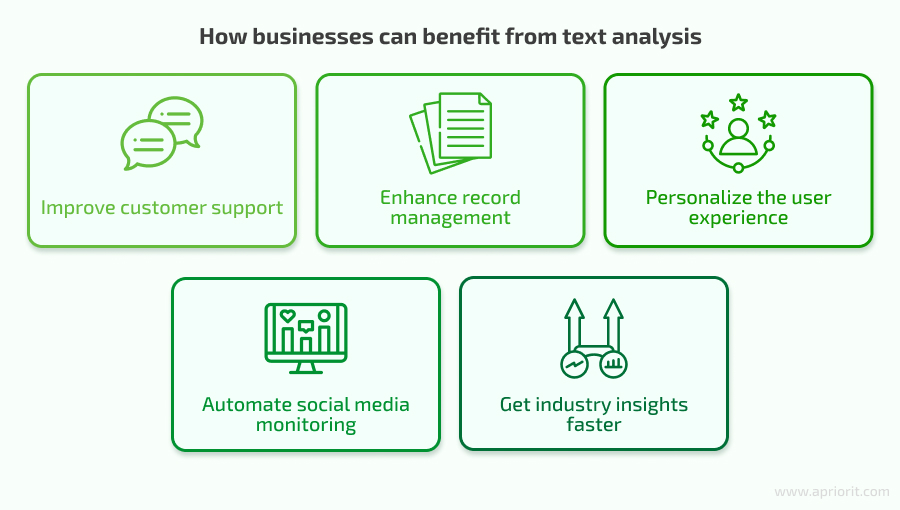
- Improve customer support. Sentiment analysis helps text mining software quickly distinguish negative reviews (containing words like bad, slow, and delays) and positive ones (containing words like good, fast, and incredible). Thus, a support team can quickly monitor sentiment in users’ reviews and prioritize processing reviews and emails that require an immediate response.
- Enhance record management. The ability of text analysis solutions to search for required information within tons of data and automatically categorize documents helps businesses efficiently manage all kinds of records. With AI-based text analysis, users can significantly accelerate precise handling of insurance records, improve accounting and financial documentation processing, automate patient record management, etc.
- Personalize the user experience. Marketing and sales managers can benefit from text analysis products when processing text-based correspondence with leads and customers or records of user behavior on websites. Text mining software can gather information about an audience’s preferences and purchasing patterns. Businesses can leverage this data to tailor personalized experiences for different customer segments.
- Automate social media monitoring. A comprehensive text analysis solution will be helpful for SMM managers, who can benefit from automated comment categorization. This allows SMM managers to immediately detect negative sentiment so they can start addressing the most urgent problems right away. They can also use already categorized positive comments for creating content and defining a brand’s main strengths. You should consider developing text analysis features for such a use case if you’re working on a social media platform project.
- Get industry insights faster. Businesses can also apply text mining to automatically process analytical reports, industry white papers, and financial forecasts. Text analysis solutions extract key information from such sources using text summarization algorithms. This helps managers more quickly spot trends across reports. Thus, organizations can gain valuable insights and use them to more quickly analyze possible business investments across various sectors and mitigate potential risks. This feature is especially helpful for banking, finance, and venture companies.
Related project
Building an AI-based Healthcare Solution
Discover how artificial intelligence capabilities can enhance healthcare systems and benefit businesses.
Technologies behind text mining
To create a text mining solution or functionality, it’s essential to know what technologies you can rely on. This allows your team to choose a technology stack depending on your project goals and needs.
Text analysis software usually leverages the following technologies:
- Machine learning (ML) — a branch of AI and computer science that offers tools to help engineers develop computer systems that can learn from data. ML algorithms and models are supposed to imitate the way humans learn while gradually improving their accuracy after training and testing. In text analysis, ML is mostly used to power text classification functionality.
- Deep learning (DL) — a subset of machine learning based on neural networks that attempts to simulate the behavior of the human brain, allowing software to learn from large amounts of data. Since DL models can recognize complex patterns, they enhance text analysis software with the ability to find required information and extract it from tons of unstructured data.
- Natural language processing (NLP) — a subfield of computer science and linguistics that uses ML and DL to reveal the structure and meaning of text. By applying NLP-based solutions, you can enable text summarization, classification, and extraction. It also powers the named entity recognition technique that we discuss below.
- Natural language understanding (NLU) — a subset of NLP that helps software to understand input in the form of sentences using text or speech. NLU enables human–computer interaction by analyzing language versus just words. In text analysis, NLU is mostly used to enhance sentiment analysis features.
- Generative AI development (GenAI) — a subfield of artificial intelligence that’s based on DL models and can generate quality content like text and images depending on the training data. In text analysis, you can use GenAI to improve the understanding of intricate linguistic patterns, empower sentiment analysis, and generate a text summary of a given document.
Text analysis methods and techniques
Your team can apply various techniques and methods to enrich your text mining software with different features. Below, we overview the nine most common:
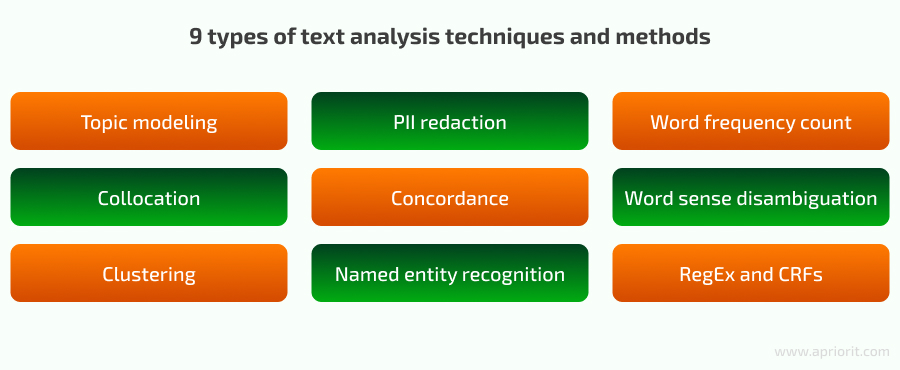
- Topic modeling makes software read multiple texts, identify and group related keywords, and sort texts by topic or theme. This provides context for further analysis of given documents.
- Personally identifiable information (PII) redaction helps you ensure privacy protection and compliance with cybersecurity requirements. Such a method automatically detects and removes names, phone numbers, addresses, social security numbers, and other sensitive data.
- Word frequency count allows you to analyze commonly used words and expressions, which can come in handy when analyzing customer behavior and creating a buyer persona. To measure the most frequently occurring words, consider using term frequency-inverse document frequency.
- Collocation aims to identify semantic structures and improve the granularity of insights. To detect words that commonly co-occur, collocation methods count bigrams and trigrams as one word. For example, in marketing materials, the words social and media are likely to co-occur rather than appear individually.
- Concordance helps text mining software better understand the context of words as well as analyze complex phrases.
- Word sense disambiguation differentiates words that have several meanings and distinguishes the right meaning. Implementing this advanced technique requires an experienced AI development team that can thoroughly train and test chosen models.
- Clustering groups quantities of unstructured data to help software categorize data for further processing. While topic modeling is a statistical technique for discovering latent topics in a collection of documents, clustering leverages ML algorithms to group similar data points.
- Named entity recognition (NER) is a technique that stands behind text extraction. This NLP-based method helps you identify, categorize, and extract the most important pieces of information from unstructured text, saving employees’ time and eliminating the risk of human errors.
- Regular expressions (RegEx) and conditional random fields (CRFs) are methods that engineers often use to create text extraction algorithms. RegEx is a powerful programming tool for a variety of purposes like extracting features from text, replacing strings, and performing other string manipulations. CRFs are a class of statistical modeling methods that are often used for structured predictions.
Note: Although modern solutions use AI for text analysis, it doesn’t mean that all software components, elements, and algorithms are AI- or ML-based. Therefore, some of the techniques and methods mentioned above are non-AI.
Read also
Top LLM Use Cases for Business: Real-Life Examples and Adoption Considerations
Implement LLMs to enhance your software capabilities, security, and efficiency. Discover how to use these AI systems to your benefit.

Three stages of text analysis
The architecture, list of features, and technology stack for your text mining solution can vary depending on the software’s goals and purposes. However, the text analysis process itself is more or less universal and consists of three stages:
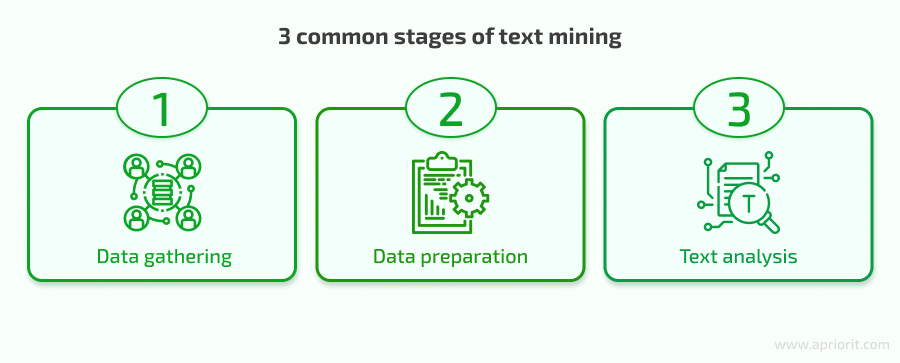
- Data gathering. A crucial first step aims to gather text data. Your team must think of an automated way for a solution to extract data from internal sources like emails, chats, invoices, and employee surveys, as well as from external sources such as social media posts, online reviews, news articles, and online forums.
- Data preparation. Then, your team must implement relevant algorithms that will provide data in a format that’s acceptable for analysis. Consider using NLP methods like tokenization, parsing, and stop words removal to make sure your AI text analysis software can automatically process the given data.
- Text analysis. The key step is to ensure the actual processing of given texts or documents. The methods to use here depend on the software’s purposes, most commonly including topic modeling, clustering, and NER.
Each text mining solution is unique and requires a custom approach to its planning and building. However, there are several universal tips from Apriorit’s AI experts that your team can follow when developing an AI system for working with texts. Let’s discuss the crucial nuances of developing text analysis features in the next section.
What to consider when developing text analysis software
Whether your project involves building a full-scale solution from scratch or developing a text mining feature for existing software, it’s vital to know what nuances and challenges to expect along the way. Below, we list crucial things to consider when it comes to developing text analysis features.
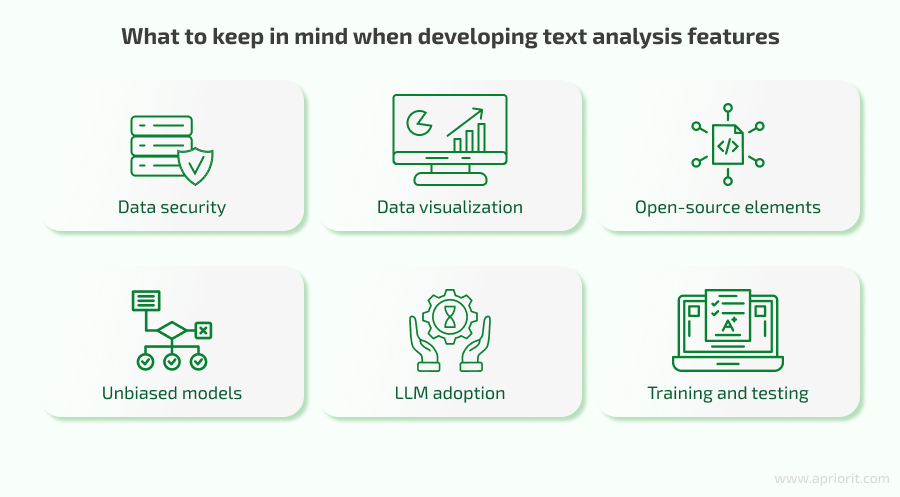
- Think of data security beforehand. Organizations use text analysis solutions to process tons of records that are likely to include sensitive data like corporate information, employees’ and users’ PII, and intellectual property. Therefore, your team must come up with a solid cybersecurity strategy for the entire development lifecycle to ensure robust data protection. A few examples of protection methods to consider are data anonymization and encryption. You should also keep in mind compliance with data protection requirements, which depend on the industry your solution targets. Apart from using common development practices like encryption, consider enhancing your QA activities with security testing.
- Plan visualization features. In this article, we focus strictly on text analysis features, but real-life software should also include data visualization features in order to be competitive. All in all, users not only want to automatically analyze documents but also to have the analysis results displayed in a user-friendly and easy-to-digest format. It’s essential to define which visualization formats your target audience prefers, be it graphs, charts, tables, or anything else before your team starts the development process. Once you define those formats, you can plan categories and clusters for your data classification features accordingly.
- Implement open-source elements. When it comes to working with AI-powered text analysis software, the rule of thumb is to use existing relevant ML and DL models. Researching and adjusting pretrained models can save your team significant time and money on trial and error processes. Instead of developing algorithms from scratch, you can focus on other aspects of the project. Other elements to search for are prepared, quality datasets for model training, as creating all needed datasets and having your team label data in them will take too much time. But make sure your team thoroughly checks open-source elements before implementing them into the product. Potential pitfalls of relying too heavily on open-source models include the risk of introducing biases and the challenge of customizing these models to fit specific business needs.
- Eradicate bias in your AI models. Any AI model has the risk of being biased, which will harm the efficiency, accuracy, and competitiveness of the final product. Reasons for bias to appear could be incomplete datasets or poorly developed and tested software. Therefore, your team members should be careful when developing their own algorithms, picking open-source models, and choosing datasets for training and testing. For instance, they can consider checking data diversity in datasets, performing additional testing activities, and arranging more comprehensive analysis of AI processing results.
- Leverage large language models (LLMs). Consider enhancing your text analysis functionality by adding LLM models or integrating your solution with popular LLM services. For instance, LLMs help automate tasks like text generation and document processing. You can also use such models to expand your product’s capabilities, introducing features for content analysis, preliminary research, text translation and localization, and fraud detection.
- Thoroughly train and test AI models. No matter how promising AI-based technologies are, there are still issues like false positives and negatives, hallucinations, and the inability to handle niche industry tasks. To minimize these risks, your team must plan enough time for AI model training and testing. Make sure to plan such activities with your product’s goals and customers in mind.
Conclusion
Dedicated text mining software can be beneficial for organizations across different industries. Various departments and specialists will benefit from the ability to automatically classify, sort, and extract information from thousands of texts. AI analysis of text and documents as an additional feature can also significantly enhance existing software, bringing extra benefits to users and helping your product stay competitive.
But to help your customers use text analysis efficiently and accurately or to make your own business benefit from its capabilities, it’s essential to entrust development to a proven vendor. At Apriorit, we have expert AI consulting and AI engineering teams with experience in ML, LLM, and text analysis development for different industries and purposes.
Have an artificial intelligence project in mind?
Build robust and secure features with the help of Apriorit’s AI specialists.


